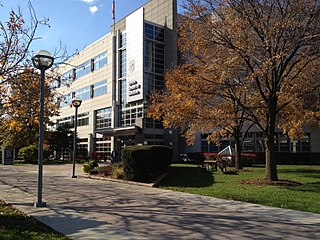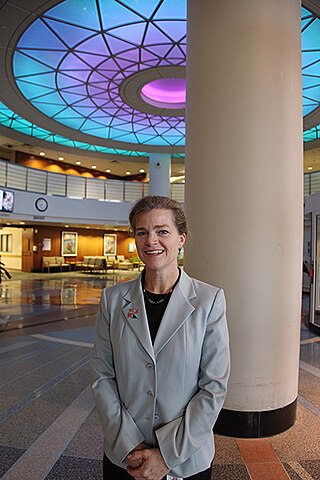Doctor of Medicine is a medical degree, the meaning of which varies between different jurisdictions. In the United States, and some other countries, the M.D. denotes a professional degree. This generally arose because many in 18th-century medical professions trained in Scotland, which used the M.D. degree nomenclature. In England, however, Bachelor of Medicine, Bachelor of Surgery (M.B.B.S.) was used and eventually in the 19th century became the standard in Scotland too. Thus, in the United Kingdom, Ireland and other countries, the M.D. is a research doctorate, honorary doctorate or applied clinical degree restricted to those who already hold a professional degree (Bachelor's/Master's/Doctoral) in medicine. In those countries, the equivalent professional degree to the North American, and some others' usage of M.D. is still typically titled Bachelor of Medicine, Bachelor of Surgery.

The Warren Alpert Medical School is the medical school of Brown University, located in Providence, Rhode Island. Originally established in 1811, it was the third medical school to be founded in New England after only Harvard and Dartmouth. However, the original program was suspended in 1827, and the four-year medical program was re-established almost 150 years later in 1972, granting the first MD degrees in 1975.

The Medical University of South Carolina (MUSC) is a public medical school in Charleston, South Carolina. It opened in 1824 as a small private college aimed at training physicians and has since established hospitals and medical facilities across the state. It is one of the oldest continually operating schools of medicine in the United States and the oldest in the Deep South.

The Edward Via College of Osteopathic Medicine (VCOM) is a private medical school on the campus of Virginia Tech in Blacksburg, Virginia, with branch campuses in Spartanburg, South Carolina, Auburn, Alabama, and Monroe, Louisiana. VCOM also recently added Bluefield University to its list of campuses. Founded in 2002, VCOM graduated its first class of 139 students in June 2007.

SUNY Downstate Medical Center is a public medical school and hospital in Brooklyn, New York. It is the southernmost member of the State University of New York (SUNY) system and the only academic medical center for health education, research, and patient care serving Brooklyn's 2.5 million residents. As of Fall 2018, it had a total student body of 1,846 and approximately 8,000 faculty and staff.

The Duke University School of Medicine, commonly known as Duke Med, is the medical school of Duke University. It is located in the Collegiate Gothic-style West Campus of Duke University in Durham, North Carolina. The School of Medicine, along with the Duke University School of Nursing, Duke University Hospital, Duke Regional Hospital, Duke Children's Hospital, Duke Raleigh Hospital, and other affiliated hospitals, clinics, and laboratories, make up the Duke University Health System. Established in 1925 by James B. Duke, the School of Medicine has earned its reputation as an integral part of one of the world's foremost patient care and biomedical research institutions.

Carolinas Medical Center (CMC) is an 874-bed non-profit, tertiary, research and academic medical center located in Charlotte, North Carolina, servicing the southern North Carolina, northern South Carolina, and the Metrolina region. Carolinas Medical Center is one of the region's only academic university-level teaching centers. The hospital is the flagship hospital of Atrium Health. Carolinas Medical Center is affiliated with the Wake Forest School of Medicine. Carolinas Medical Center is also an ACS designated level I trauma center and has a heliport to handle medevac patients. Attached to the medical center is the Levine Children's Hospital, treating infants, children, adolescents, and young adults.

UNC Health is a not-for-profit medical system owned by the State of North Carolina and based in Chapel Hill, North Carolina at the University of North Carolina at Chapel Hill. It provides services throughout the Research Triangle and North Carolina. UNC Health was created in 1998, when the North Carolina General Assembly passed legislation that established the UNC Health Care System, bringing under one entity UNC Hospitals and the clinical programs of the UNC School of Medicine. In 2018, the system reported over 3.5 million outpatient visits and over 500,000 emergency visits.
Wake Forest University School of Medicine is the medical school of Wake Forest University, with two campuses located in Winston-Salem, North Carolina and Charlotte, North Carolina, United States. It is affiliated with Atrium Health Wake Forest Baptist, the academic medical center whose clinical arm is Atrium Health Wake Forest Baptist. In 2021, U.S. News & World Report ranked Wake Forest School of Medicine 48th best for research in the nation and 80th best for primary care. The School of Medicine also ranks in the top third of U.S. medical schools in funding from the National Institutes of Health (NIH).
The University of Cincinnati Academic Health Center (AHC) is a collection of health colleges and institutions of the University of Cincinnati, Cincinnati, Ohio. It trains health care professionals and provides research and patient care. AHC has strong ties to UC Health, which includes the University of Cincinnati Medical Center and West Chester Hospital.

The Lewis Katz School of Medicine at Temple University (LKSOM), located on the Health Science Campus of Temple University in Philadelphia, PA, is one of 7 schools of medicine in Pennsylvania conferring the M.D. degree. It also confers the Ph.D. and M.S. degrees in biomedical sciences. In addition, LKSOM offers a Narrative Medicine Program.

Kansas City University (KCU) is a private medical school with its main campus in Kansas City, Missouri and an additional campus in Joplin, Missouri. Founded in 1916, KCU is one of the original osteopathic medical schools in the United States. It consists of both a College of Osteopathic Medicine and a College of Biosciences. KCU is one of the largest medical schools in the nation by enrollment.

Stritch School of Medicine is the medical school affiliated with Loyola University Chicago. It is located at the heart of the Loyola University Medical Center in Maywood, Illinois. The medical campus includes Foster G. McGaw Hospital, Cardinal Bernardin Cancer Center, Center for Translational Research and Education, the Loyola Outpatient Center, the Loyola University Center for Health and Fitness along with other administrative buildings and departments that branch off from the hospital. While the Loyola University hospital, outpatient clinic and satellite sites serve as the main places of teaching, the Edward Hines Veterans Administration (VA) hospital is within walking distance and also serves as a teaching hospital for the Stritch School of Medicine.
Duke University Hospital is a 957-bed acute care facility and an academic tertiary care facility located in Durham, North Carolina. Established in 1930, it is the flagship teaching hospital for the Duke University Health System, a network of physicians and hospitals serving Durham County and Wake County, North Carolina, and surrounding areas, as well as one of three Level I referral centers for the Research Triangle of North Carolina. It is affiliated with the Duke University School of Medicine.

The Texas Tech University Health Sciences Center School of Medicine is the medical school of Texas Tech University Health Sciences Center (TTUHSC). TTUHSC SOM was originally chartered in 1969 to train more physicians for the underserved populations of the West Texas region. As of 2011, the School of Medicine has awarded over 4,000 Doctor of Medicine degrees. The school offers the traditional four-year curriculum, as well as an accelerated three-year track, and joint degree programs with Texas Tech University.
The North Carolina Area Health Education Centers Program provides the central leadership and support for all of the regional NC Area Health Education Centers (AHECs). It is located on the campus of the University of North Carolina School of Medicine in Chapel Hill, NC.

Julie Story Byerley is an American physician who is known as a leader in the fields of medical education and pediatrics. Byerley has served as a clinical professor and Vice Dean for Education for the University of North Carolina at Chapel Hill School of Medicine. She currently serves as President and Dean of Geisinger Commonwealth School of Medicine as well as Executive Vice President and Chief Academic Officer for Geisinger Health System.
Carol Fowler Durham is an American Clinical Professor of Nursing and Doctor of Education who is known as a leader in the fields of Healthcare Quality and Safety, nursing education, interprofessional education, and medical simulation.













